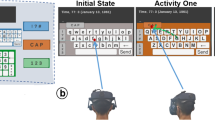Abstract
Text entry has become one of the most frequent activities performed using mobile devices such as PDAs. Virtual keyboards (VK), which allow text to be entered by tapping keys displayed on the screen, are among the predominant mode of text input for such devices. It is important to design VK layouts in a way such that the users can achieve high text entry speed with high accuracy. Several layouts, primarily in English and also in some other languages, have been proposed to achieve the twin objectives. However, no such work has been reported for Bengali, the second and fifth most popular language of India and the world, respectively. The existing methods cannot be applied directly to Bengali VK design due to the problem of accommodating the large Bengali alphabet (more than 60 characters) on a small display area. In order to resolve the resulting usability-performance trade-off, this paper proposes a two-level design. Five two-level VKs representing three design paradigms (alphabetic, frequency-based and adaptive) have been designed and compared in an empirical study. The study results show that for mobile devices, the two-level adaptive design is expected to give best performance in terms of text entry rate and accuracy. The layouts as well as the procedure and results of the study are discussed in this paper.








Similar content being viewed by others
Notes
Developed by Tegic Communication Inc., now part of Nuance (http://www.nuance.com/).
In the subsequent discussion, the terms ‘level’ and ‘subset’ are used interchangeably.
References
Arif, A.S., Stuerzlinger, W.: Analysis of text entry performance metrics. In: Proceedings of IEEE Symposium on Human Factors and Ergonomics, pp. 100–105 (2009)
Beukelman, R.D., Mirenda, P.: Augmentative and Alternative Communication, 2nd edn. Brookes, Baltimore (1998)
Cook, A.M., Hussey, S.M.: Assistive Technologies: Principles and Practice, 2nd edn. Mosby-Year Book, St. Louis (2001)
Garay-Vitoria, N., Abascal, J.: Text prediction systems: a survey. Univ. Access Inf. Soc. 4, 188–203 (2006)
Getschow, C.O., Rosen, M.J., Goodenough-Trepagnier, C.A.: Systematic approach to design a minimum distance alphabetical keyboard. In: Proceedings of RESNA (Rehabilitation Engineering Society of North America) 9th Annual Conference (1986)
Hansen, J.P., Torning, K., Johansen, A.S., Itoh, K., Aoki, H.: Gaze typing compared with input by head and hand. In: Proceedings of the 2004 Symposium on Eye Tracking Research and Applications, pp. 131–138, San Antonio (2004)
Joshi, A., Ganu, A., Chand, A., Parmer, V., Mathur, G.: Keylekh: A keyboard for text entry in indic scripts. In: CHI’04 Extended Abstracts on Human Factors in Computing Systems, pp. 928–942 (2004)
Krishna, A., Ajmera, R., Halarnkar, S., Pandit, P.: Gesture keyboard—user centered design of a unique input device for indic scripts. In: Proceedings of HCI International 2005 (HCII05), Las Vegas (2005)
Lesher, G.W., Moulton, B.J.: An introduction to the theoretical limits of abbreviation expansion performance. In: Proceedings of the RESNA 2005 Annual Conference (2005)
Lesher, G.W., Moulton, B.J., Higginbotham, D.J.: Optimal character arrangements for ambiguous keyboards. IEEE Trans. Rehabil. Eng. 6, 415–423 (1998)
Lesher, G.W., Moulton, B.J., Higginbotham, D.J.: Techniques for augmenting scanning communication. Augment. Altern. Commun. 14, 81–101 (1998)
Levine, S.H., Goodenough-Trepagnier, C.: Customised text entry devices for motor-impaired users. Appl. Ergonomics 21, 55–62 (1990)
MacKenzie, I.S.: The one-key challenge: searching for a fast one-key text entry method. In: Proceedings of the 11th International ACM SIGACCESS Conference on Computers and Accessibility, pp. 91–98, Pittsburgh (2009)
MacKenzie, I.S., Soukoreff, R.W.: Text entry for mobile computing: models and methods, theory and practice. Hum. Comput. Interact. 17, 147–198 (2002)
MacKenzie, I.S., Tanaka-Ishii, K. (eds.): Text Entry Systems: Mobility, Accessibility, Universality. Morgan Kauffmann, Burlington (2007)
Manning, C., Schultze, H.: Foundations of Statistical Natural Language Processing. MIT Press, Cambridge (1999)
Mirvaziri, H., Javidi, M.M., Mansouri, N.: Handwriting recognition algorithm in different languages: survey. In: Visual Informatics: Bridging Research and Practice, vol. 5857/2009 of Lecture Notes in Computer Science, pp. 487–497. Springer, Berlin (2009)
Mukherjee, A., Bhattacharya, S., Halder, P., Basu, A.: A virtual predictive keyboard as a learning aid for people with neuro-motor disorders. In: Proceedings of 5th IEEE International Conference on Advanced Learning Technology (ICALT-05), Kaohsiung, pp. 1032–1036 (2005)
Norman, D.: Design of Everyday Things. Basic Books, New York (1988)
Plamondon, R., Srihari, S.N.: On-line and off-line handwriting recognition: a comprehensive survey. IEEE Trans. Pattern Anal. Mach. Intell. 22, 63–84 (2000)
Raynal, M., Vigouroux, N.: Genetic algorithm to generate optimized soft keyboard. In: Proceedings of CHI 2005, pp. 1729–1732, Oregon (2005)
Rosen, M.J., Goodenough-Trepagnier, C.: Factors affecting communication rate in non-vocal communication systems. In: Proceedings 4th Annual Conference on Rehabilitation Engineering, pp. 194–196 (1981)
Shanbag, S., Rao, D., Joshi, R.K.: An intelligent multi-layered input scheme for phonetic scripts. In: Proceedings of the Symposium on Smart Graphics, pp. 35–38, Howthorne, 11–12 June (2002)
Soukoreff, R.W., MacKenzie, I.S.: Theoretical upper and lower bounds on typing speed using a stylus and soft keyboard. Behav. Inf. Technol. 14, 370–379 (1995)
Soukoreff, R.W., MacKenzie, I.S.: Metrics for text entry research: an evaluation of MSD and KSPC, and a new unified error metric. In: Proceedings of CHI 2003, pp. 113–120 (2003)
Tanenbaum, A.S.: Modern Operating System, 3rd edn. Prentice Hall, Upper Saddle River (2007)
Trnka, K., McCaw, J., Yarrington, D., McCoy, K.F., Pennington, C.: User interaction with word prediction: the effects of prediction quality. ACM Trans. Access. Comput. (TACCESS), 1(3) (2009)
Venkatagiri, H.S.: Efficient keyboard layouts for sequential access in augmentative and alternative communication. Augment. Altern. Commun. 15, 126–134 (1999)
Zhai, S., Hunter, M., Smith, B.A.: Performance optimization of virtual keyboards. Hum. Comput. Interact. 17, 89–129 (2002)
Acknowledgments
We are thankful to the volunteers for agreeing to take part in the empirical study.
Author information
Authors and Affiliations
Corresponding author
Rights and permissions
About this article
Cite this article
Bhattacharya, S., Laha, S. Bengali text input interface design for mobile devices. Univ Access Inf Soc 12, 441–451 (2013). https://doi.org/10.1007/s10209-012-0280-1
Published:
Issue Date:
DOI: https://doi.org/10.1007/s10209-012-0280-1




